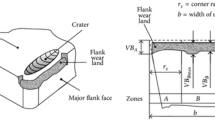Abstract
Tool wear is accelerated with the friction in the tool–workpiece contact during dry cutting. Tool changing early or late will affect the quality of tool and workpiece. An online and machine system vision-based is built to monitor tool condition in real time. MATLAB is used to compile the self-matching algorithm, which considers the features of interested targets on the flank face. Furthermore, a corresponding GUI is designed and encapsulated for both the bottom and flank edges. It is shown that the absolute value of the error on the maximum wear width is not more than 0.007 mm for the bottom edge. For the flank edge, the absolute value of the error is not more than 0.030 mm owing to the local highlighting interference. It is proved that the system can guarantee the quality of tool and workpiece and avoid unnecessary waste significantly. This platform can enhance the utilization of the tool in dry cutting.
















Similar content being viewed by others
References
Huang PL, Li JF, Sun J, Zhou J (2014) Study on performance in dry milling aeronautical titanium alloy thin-wall components with two types of tools. J Clean Prod 67:258–264
Lawal SA, Choudhury IA, Nukman Y (2013) A critical assessment of lubrication techniques in machining processes: a case for minimum quantity lubrication using vegetable oil-based lubricant. J Clean Prod 41:210–221
Zhang S, Li JF, Wang YW (2012) Tool life and cutting forces in end milling Inconel 718 under dry and minimum quantity cooling lubrication cutting conditions. J Clean Prod 32:81–87
Li KM, Liang SY (2007) Modeling of cutting forces in near dry machining under tool wear effect. Int J Mach Tools Manuf 47:1292–1301
Sun X G, Sun L, Wang E H (2014) Study on joint surface parameter identification method of shaft-toolholder and toolholder-tool for vertical CNC milling machine. Mach Tool & Hydr 42(23):106-109.
Wang B, Sun W, Wen BC (2012) The finite element modeling of high-speed spindle system dynamics with spindle-holder-tool joints. Aust J Mech Eng (15):83–89
Ghani JA, Rizal M, Nuawi MZ, Ghazali MJ, Haron CHC (2011) Monitoring online cutting tool wear using low-cost technique and user-friendly GUI. Wear 271(9–10):2619–2624
Gómez MP, Hey AM, Ruzzante JE, Attellis CED (2010) Tool wear evaluation in drilling by acoustic emission. Phys Procedia 3(1):819–825
Chen XQ, Li HZ (2009) Development of a tool wear observer model for online tool condition monitoring and control in machining nickel-based alloys. Int J Adv Manuf Technol 45(7-8):786–800
Maia LHA, Abrao AM, Vasconcelos WL, Sales WF, Machado AR (2015) A new approach for detection of wear mechanisms and determination of tool life in turning using acoustic emission. Tribol Int 92:519–532
Malekian M, Park SS, Jun MBG (2009) Tool wear monitoring of micro-milling operations. J Mater Process Technol 209(10):4903–4914
Wang G, Guo Z, Yang Y (2013) Force sensor based online tool wear monitoring using distributed Gaussian ARTMAP network. Sens Actuators A Phys 192(7):111–118
Shi XC, Wang XB, Jiao L, Wang Z, Yan P, Gao SF (2018) A real-time tool failure monitoring system based on cutting force analysis. Int J Adv Manuf Technol 95(5-8):2567–2583
Kim JH, Moon DK, Lee DW, Kim JS, Kang MC, Kim KH (2002) Tool wear measuring technique on the machine using CCD and exclusive jig. J Mater Process Technol 130-131(02):668–674
Loizou J, Tian W, Robertson J, Camelio J (2015) Automated wear characterization for broaching tools based on machine vision systems. J Manuf Syst 37:558–563
Zhang JL, Zhang C, Guo S, Zhou LS (2012) Research on tool wear detection based on machine vision in end milling process. Prod Eng 6(4-5):431–437
Zhang C, Zhang JL (2013) On-line tool wear measurement for ball-end milling cutter based on machine vision. Comput Ind 64(6):708–719
Xin Y C (2016) The parameters of tool wear detection technology research. Dissertation, Xi’an Technological University
Bradley C, Wong YS (2001) Surface texture indicators of tool wear - a machine vision approach. Int J Adv Manuf Technol 17(6):435–443
Datta A, Dutta S, Pal SK, Sen R, Mukhopadhyay S (2012) Texture analysis of turned surfaces using grey level co-occurrence technique. Adv Mater Res 365:38–43
Mannan MA, Zhu M, Kassim AA (2004) Tool wear monitoring using a fast Hough transform of images of machined surfaces. Mach Vis Appl 15(3):156–163
Sun LL, Li Y, Zheng JM, Li PY (2010) Fractal analysis of PCA reconstruction for tool wear monitoring. Mech Sci Tech Aero Eng 29(3):395–397
Zhang G, To S, Xiao G (2014) Novel tool wear monitoring method in ultra-precision raster milling using cutting chips. Precis Eng 38(3):555–560
Wang C C (2014) On-site tool wear detection based on high precision computer vision. Dissertation, Donghua University
Hou QL, Sun J, Huang PL (2018) A novel algorithm for tool wear online inspection based on machine vision. Int J Adv Manuf Technol 101(9):2415–2423
Acknowledgments
The authors want to extend sincere thanks to all the previous researches that contributed to this paper.
Funding
This study is supported by the AVIC Cheng Du Aircraft Industrial (Group) Co. Ltd. (grant no. 2014-063), Key R & D project of Shandong Province (grant no. 2017GGX30141), and difital workshop of aeronautic large-scale complex structural (intelligent manufacturing special support by Ministry of Industry and Information Technology in 2015) (grant no. 40205000150X).
Author information
Authors and Affiliations
Corresponding author
Additional information
Publisher’s note
Springer Nature remains neutral with regard to jurisdictional claims in published maps and institutional affiliations.
Rights and permissions
About this article
Cite this article
Hou, Q., Sun, J., Lv, Z. et al. An online tool wear detection system in dry milling based on machine vision. Int J Adv Manuf Technol 105, 1801–1810 (2019). https://doi.org/10.1007/s00170-019-04367-w
Received:
Accepted:
Published:
Issue Date:
DOI: https://doi.org/10.1007/s00170-019-04367-w




